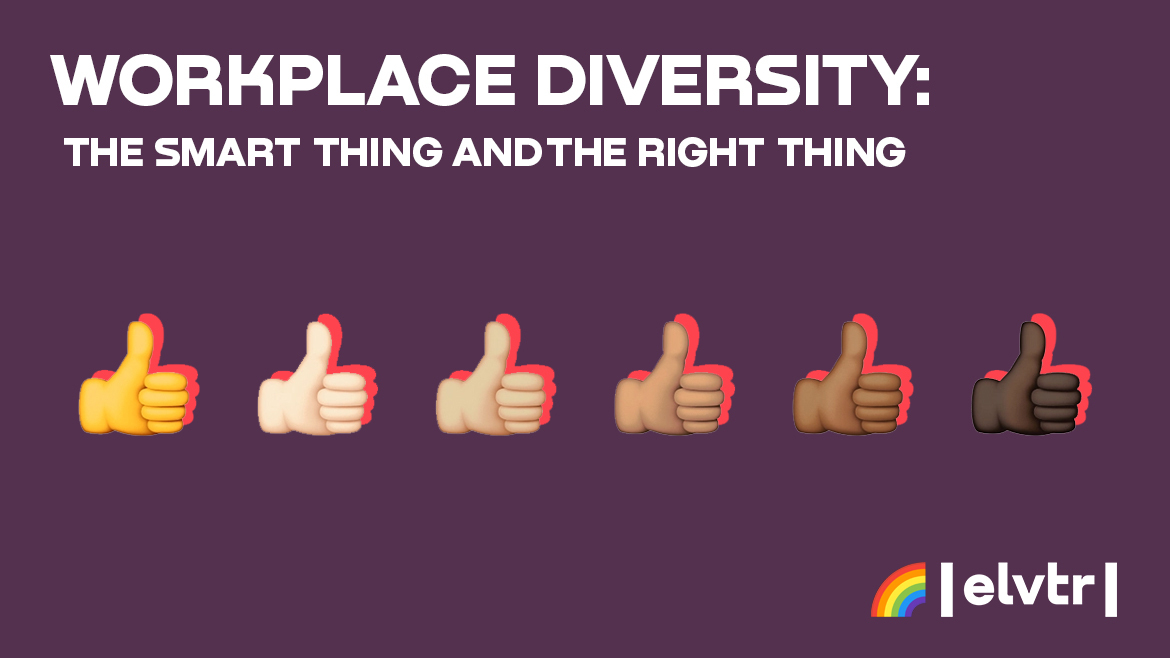- MAIN PAGE
- – elvtr magazine – WORKPLACE DIVERSITY: THE SMART THING AND THE RIGHT THING
WORKPLACE DIVERSITY: THE SMART THING AND THE RIGHT THING

IT'S A SMALL WORLD AFTER ALL.
Every step and innovation we make in this world only serves to prove this statement true. We are all in this together, and for many, this can be a boon. For other businesses and industries though, this can require a change in thinking or even a complete restructure of the workplace.
For the past several decades, diversity in the office has been a hot-button issue. What does diversity look like? How does one accomplish legitimate diversity? Why should we even integrate diversity in our work environment?
In a world market, shouldn't every company simply operate how they see fit and make decisions within the echo chamber that has brought them success thus far? In a phrase, “if it ain’t broke, don’t fix it,” right?
What this mindset misses is the difference between working versus succeeding. Most businesses do not seek to simply survive, but to thrive.
FOR A COMPANY TO THRIVE, IT MUST INNOVATE AND DIVERSIFY.
Obviously, this statement cannot stand on its own. Associating diversity with success with no evidence is a false equivalence. We have no definition of diversity in and of itself. We have no terms by which to quantify success, and no facts or figures to back up this correlation.
Keep reading, we're going to fix that.
Now some would argue the stakes of this conversation go beyond the bottom line. If one must prove that discrimination by race, class, or gender is not profitable in order to abstain from it, then one could infer that they do not see discrimination as an issue.
We are not going to debate whether or not discrimination is wrong here, because honestly, we should not have to. Thankfully for us though, diversity is morally right and fiscally smart.
GOOD FOR THE COMPANY, GOOD FOR THE COUNTRY.
First, we need to define diversity.
As the world has reached a new level of community and connectivity, the scope of what defines a person's background, assumptions, and privilege has widened as well. Although the definition of diversity itself has not changed, people’s understanding of it has expanded.
We do not simply look at gender, race, and ethnicity as the only baselines of what makes a workplace diverse. Sexual orientation, socioeconomic upbringings, political beliefs, education levels, and disabilities — factor into creating a workplace that accurately portrays the world in which that company exists.
It has often been the establishment of industry norms that has stalled progression, and therefore capped success.
In terms of stigma, there has always been pushback to quota filling among the majority populations. Nepotism, tradition, and inherent societal discrimination — go hand in hand with the expectation of standard education and experience as requisites for employment.
These standards have often made it difficult for those coming from other countries, for example, to establish their expertise and valuable perspective within innovative industries.
The Hamilton Project
An economic policy initiative at the Brookings Institution dedicated to publishing economic strategy papers, put together a collection of research in 2018 detailing the effects that highly skilled immigration has on the innovation of scientific and technological industries.
They found that "Immigrants to the United States tend to generate more patentable technologies than natives: though they constitute only 18 percent of the 25 and older workforce, immigrants obtain 28 percent of high-quality patents.”
Immigrants also, according to the report by The Hamilton Project, skew more likely to possess higher education and college-level degrees than natives of a given country.
Their inclusion in a company also spells success for the country that company operates out of. GDP growth in countries that employ highly educated immigrants see an increase in their economy.
In the United States for example, “One estimate suggests that the total annual contribution of foreign-born workers is roughly $2 trillion, or about 10 percent of annual GDP.”
The United Kingdom’s Migration Advisory Committee found the same to be true for their country. “...the average net fiscal contribution of an immigrant was £440 more than that of a native.”
On top of all of this, the effect that bringing in educated members of other countries has on a company's reputation cannot be understated. Diversity allows a company to branch out beyond the scope of their national perspective. The world operates at an international level.
Resigning a business to a single pool of traditional employees can hurt both the perspective the company has on the world as well as the perspective that the world has on that company.
WHEN YOU DO THE RIGHT THING — YOU STAND OUT.
Companies can be made or broken by their reputation. Public relations, human resources, even casual Fridays. Large swaths of day-to-day business are designed to create a professional, endearing, and attractive image for the public to see.
When a business makes the effort to build a diverse team, the peers notice.
A 2014 study helmed by Harvard Professor Richard Freeman and Harvard Ph.D. candidate Wei Huang explored the expectation and quality output of diverse groups within the world of published research.
After sifting through 1.5 million scientific papers written between 1985 and 2008, Wei and Professor Freeman “found that papers written by diverse groups receive more citations and [had] higher impact factors than papers written by people from the same ethnic group.”
Just like in a business setting, where being the talk of the industry is key to the development of your brand and success, citations and impact factors are essential to published papers. They allow research and development to garner praise and guarantee continued monetary investments.
Professor Freeman's team attributed much of the success of these publications as a reflection of more intellectual diversity.
It should be noted that the quality of these papers was not part of the study, simply the reception and reaction. There's an understood concept when we discuss the influence of diversity as a positive. It is called “informational diversity”.
The idea is simple. The more people you involve in the development of a solution — the greater quantity of information, opinions, and perspectives that are brought to the found conclusion.
The takeaway for businesses is that notoriety is a powerful force. Often seen as the end goal within a marketing or advertising business, the ability to gain a strong reputation in your industry simply by creating a more well-rounded breadth of employees cannot be understated.
Recommended courses
WHO’S YOUR BOSS?
Every facet of diversity discussed thus far has been focused on building a culture within the workplace. What if that culture was ingrained in your company though? If diversity had sway in your managerial structure from top to bottom, who would be calling the shots?
Trustworthy management is key to a consistent and successful business. While it behooves any company to have a well-diversified workforce, the true benefit of diversity can be seen when management represents that workforce not just in priorities, but also in diverse demographics.
The inclusion of diverse management has been linked to a significant increase in financial performance.
The Boston Consulting Group, one of the world's three largest strategy consulting firms, performed their own study on bringing in more diverse team leads, and found that “companies that have more diverse management teams have 19% higher revenue due to innovation.”
They analyzed innovation by taking percentages of total revenue increase over several years and tracking the trends. So whether you are looking for innovation or simply pure profits, diversity within your workplace makes sense on every level.
It is important at this point though, to define what is not diversity.
The Boston Consulting Group also found that diversity has to be a legitimate part of the company concept, and not simply a few choice employees. Defining a "non-trivial percentage" as less than 20%, they found no increase in innovation or profits when representation dipped below these percentages.
Classically known as "tokenism", it is crucial to understand that simply hiring a few people of color as managers, or a couple of female business partners — is not enough to create a workplace of diversity.
This trend of developing minimal “quotas” has been a thorn in the side of culturally diverse workplaces for decades.
INCLUSION IS THE KEY
Michael Evans is an expert on Human Resources and a CHRO at Korn Ferry, a leading management consulting firm based in Los Angeles. With the wealth of experience on what makes or does not make a workplace environment diverse, Evans is the perfect brain to pick when pursuing true diversity.
On this topic of “tokenism”, Evans cautioned companies.
“Narrowly defined diversity initiatives (i.e. ‘we need more women’), enforced with quotas, and lacking inclusion efforts do more harm than good.
They do not necessarily deliver any benefits, and risk creating resentment, eroding trust, and somewhat paradoxically creating a less inclusive environment overall as a way of excluding minorities.”
MICHAEL EVANS /
CHRO @ KORN FERRY
Evans continued, “For example, I’ve heard a woman speak of wondering aloud at a meeting with peers if her peers were thinking, ‘she’s just here because she is a woman.’ In another case, where the company was using quotas and using color and fonts to identify them, I heard a black woman say, ‘I am not a purple italic’.”
A recent example of this is the story of Orion Black. A tabletop game designer, Black was hired by Wizards of the Coast, a prominent boardgame company responsible for dungeons and Dragons and Magic: The Gathering.
After a contracted tenure, Black released a lengthy statement about his time at the large corporation.
“I worked hard for a very long time. I got a lot of smiles and vocal support, but it was followed by inaction and being ignored,” explained Black.
“I realized at one point that leadership had given me 2 assignments over about 5 months. I firmly believe that I was a diversity hire.”
This common corporate pitfall stems from diversity without inclusion. Evans believes that inclusion is giving all people equal opportunity within the company. What we are unfortunately seeing is that some companies have filled quotas but have not given those in the minority equal opportunity to contribute.
The studies discussed have been able to boil diversity and inclusion down to a fiscal advantage. Evans maintains though, that the true value allows organizations to benefit from a diversity of thought.
*ELVTR is disrupting education by putting proven industry leaders in a virtual classroom with eager rising stars. ELVTR courses offer 100% instructor driven content designed to give you practical knowledge within a convenient time frame. Choose the right course for you!

